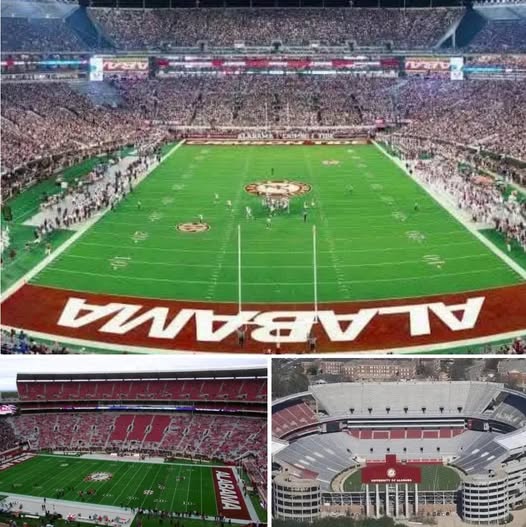GROUND BREAKING: JUST IN: Bryant-Denny Stadium, home to the University of Alabama Crimson Tide football team, has been named the greatest SEC stadium of all time
In a resounding declaration that has electrified fans, shocked rivals, and reaffirmed a long-standing legacy, Bryant-Denny Stadium has officially been named the greatest stadium in Southeastern Conference (SEC) history. This groundbreaking announcement comes after months of comprehensive analysis, fan voting, and expert evaluation led by a panel of college football historians, former players, architects, and journalists. The result? A unanimous crowning of the University of Alabama’s iconic home field as the undisputed pinnacle of SEC football venues.
This distinction isn’t merely ceremonial—it’s a powerful recognition of decades of tradition, dominance, and architectural evolution that have made Bryant-Denny Stadium not just a place where football is played, but a hallowed ground where legends are born.
Located in the heart of Tuscaloosa, Alabama, Bryant-Denny has long been a symbol of Crimson Tide excellence. Since its original construction in 1929, the stadium has grown and transformed alongside the team it hosts, rising from modest beginnings into a colossus of college football. With a current capacity of over 100,000 fans, it is the eighth-largest stadium in the world and the fourth-largest in the United States. But its greatness goes far beyond mere size.
Bryant-Denny Stadium has become synonymous with dominance. Under the leadership of coaching icons like Paul “Bear” Bryant and Nick Saban, the stadium has witnessed some of the most storied games in college football history. It has served as the fortress where national titles have been forged, where Heisman campaigns were launched, and where opponents’ hopes have repeatedly been dashed on a field that has often felt like sacred territory to the Alabama faithful.
What truly sets Bryant-Denny apart, however, is not just its history or the success of the team it houses—though both are unmatched. It is the entire experience that transforms a fall Saturday in Tuscaloosa into something approaching religious. From the moment fans enter the Walk of Champions, where statues of Alabama’s national championship-winning coaches greet them, to the deafening roar as the Tide takes the field, every aspect of the game day environment is saturated in tradition and pride.
The selection committee responsible for bestowing this historic honor cited several key reasons for Bryant-Denny’s top placement, including architectural grandeur, fan engagement, historical significance, and overall atmosphere. One member of the committee, longtime SEC analyst Tony Barnhart, remarked, “Bryant-Denny isn’t just a stadium—it’s a shrine to college football. There’s an energy, a feeling in the air there that you don’t get anywhere else. It’s not about hype. It’s about legacy.”
That legacy is impossible to ignore. Since 1929, Bryant-Denny has been a central stage for the rise of the Alabama football dynasty. Originally known simply as Denny Stadium—named after then-University President George H. Denny—it was renamed in 1975 to honor the legendary Bear Bryant, whose name alone still sends shivers through the spine of SEC rivals. During Bryant’s tenure, the stadium saw unparalleled success, and his coaching prowess elevated not only the Alabama program but the profile of the entire conference.
That tradition of excellence didn’t end with Bryant. In the 21st century, under the stewardship of Nick Saban, the stadium has arguably reached even greater heights. Saban’s teams have made Bryant-Denny the most intimidating venue in college football. Since Saban took the helm in 2007, the Crimson Tide has boasted a near-impenetrable home record, with streaks of 20+ consecutive wins at home and dominant performances against SEC and non-conference powerhouses alike. Bryant-Denny became a site where championship aspirations of visiting teams were routinely buried beneath the weight of Alabama’s precision and power.
The stadium’s modernization has paralleled the team’s evolution. Major renovations and expansions over the past two decades have turned Bryant-Denny into a state-of-the-art coliseum. The most recent renovations, completed in 2020, added premium seating, a massive scoreboard, and improved amenities—all while preserving the stadium’s historical character. These changes didn’t just make the stadium more comfortable; they made it more formidable.
It’s also worth noting the stadium’s role in Alabama’s culture, and indeed, in the culture of the American South. In many ways, Bryant-Denny is more than a football venue—it is a central node in the identity of a state and a people. For countless fans, Saturdays in the stadium are family traditions, reunions, and spiritual revivals rolled into one. The stadium’s unmistakable voice—the echoes of “Rammer Jammer” after a dominant victory, the thunderous applause for a Tide touchdown, the collective hush before a crucial fourth down—resonates deep in the soul of Alabama fans across generations.
Of course, the SEC boasts several legendary stadiums—each with its own unique lore and legacy. The Swamp in Gainesville, Tiger Stadium in Baton Rouge, Sanford Stadium in Athens, and Neyland Stadium in Knoxville all have fierce reputations and rabid fanbases. Each has been a battleground for epic clashes and unforgettable moments. But in the end, what separated Bryant-Denny was the completeness of its package: championship pedigree, historical significance, fan culture, and modern excellence.
The fan response to the announcement has been predictably ecstatic. Social media platforms have exploded with celebratory posts, videos from past victories, and emotional testimonials from alumni and long-time Tide fans. University of Alabama President Stuart Bell issued a statement calling the recognition “a fitting tribute to the spirit of our university and our commitment to excellence.” Head coach Kalen DeBoer, entering his first full season at the helm after Nick Saban’s retirement, also spoke to the press, saying, “It’s an honor to step onto that field knowing what it represents. The standard here is unlike anything in sports, and Bryant-Denny is the heart of that tradition.”
Even rivals have acknowledged the stadium’s stature—grudgingly, perhaps, but sincerely. One unnamed SEC assistant coach was quoted saying, “It’s the hardest place to play in the country. The fans are relentless, the team is always prepared, and you feel the history when you walk in. There’s just something different about that place.”
Critics may argue that crowning any stadium as the greatest is inherently subjective, and they wouldn’t be wrong. But what cannot be denied is the impact that Bryant-Denny has had not just on Alabama football, but on the college football world at large. From hosting national championships to sending generations of players to the NFL, from the Bear Bryant era to the Saban dynasty, the stadium has been the backdrop to a level of sustained greatness that few others can rival.
And now, with a new chapter beginning under DeBoer and the next generation of Crimson Tide players taking the field, Bryant-Denny continues to evolve. But even as new players come and go, even as college football undergoes seismic shifts through NIL, conference realignment, and playoff expansion, one constant remains: Bryant-Denny is the beating heart of college football’s most successful program.
The honor of being named the greatest SEC stadium of all time is not just a trophy to be placed on a shelf—it’s a recognition of a legacy still being written. With every snap, every cheer, every echoing roar from 100,000 strong, the legend of Bryant-Denny grows.
And now, with the title officially bestowed, it’s not just a belief held by Alabama fans. It’s a fact etched into college football history.
Bryant-Denny Stadium isn’t just the home of the Crimson Tide.
It is, undeniably, the home of greatness.



